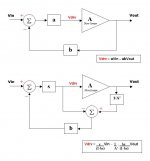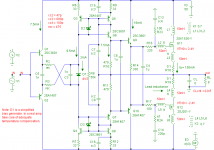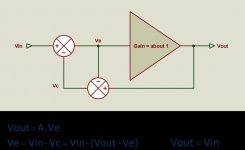Rodolfo,
Things start to click into place. Your distinction between nfb-only and ec now also makes more sense. Nfb-only cannot, even in theory, decrease the errors to zero (Lipshitz and Vanderkooij have shown that also) so it can only get there 'asymptotically': close, but not quite. Ec can in theory at least null te error to zero, your term 'cancellation'.
Jan Didden
Things start to click into place. Your distinction between nfb-only and ec now also makes more sense. Nfb-only cannot, even in theory, decrease the errors to zero (Lipshitz and Vanderkooij have shown that also) so it can only get there 'asymptotically': close, but not quite. Ec can in theory at least null te error to zero, your term 'cancellation'.
Jan Didden
Jan,
So much wishful thinking. 🙂
Rodolfo is talking about cancellation within the PFB network. The output errors are subject to the system equations which are identical in form in both cases. There is no distinction between the two at the system level.
Brian
So much wishful thinking. 🙂
Rodolfo is talking about cancellation within the PFB network. The output errors are subject to the system equations which are identical in form in both cases. There is no distinction between the two at the system level.
Brian
Dear
I could join the discussion and argue that 'ideal error cancellation' implies 'never cliping' or vice versa but I'd rether ask all of you to show some (more) circuits of error correction and to share some practical experience with them.
regards
Adam
I could join the discussion and argue that 'ideal error cancellation' implies 'never cliping' or vice versa but I'd rether ask all of you to show some (more) circuits of error correction and to share some practical experience with them.
regards
Adam
I don't see why so mutch discution about?
Feed backward EC or NFB can not cancel error completely, this is just physically or mathematically impossible. Feedforward EC can do it.
traderbam is wright.
Feed backward EC or NFB can not cancel error completely, this is just physically or mathematically impossible. Feedforward EC can do it.
traderbam is wright.
dadod said:I don't see why so mutch discution about?
Feed backward EC or NFB can not cancel error completely, this is just physically or mathematically impossible. Feedforward EC can do it.
traderbam is wright.
I agree that physically, meaning actually building the stuff, neither method can zero the error.
But the crux of my post was that nfb cannot do it in mathematics, in theory, either, while ec CAN in theory, mathematically, zero the error.
Do the maths, you'll see.
Jan Didden
darkfenriz said:Dear
I could join the discussion and argue that 'ideal error cancellation' implies 'never clipping' or vice versa but I'd rather ask all of you to show some (more) circuits of error correction and to share some practical experience with them.
regards
Adam
Hi Adam,
I've tried to do just that, but for some mysterious reason, my picture wasn't accepted. I've asked Stuart for help, so let's hope he find out what went wrong.
Cheers, Edmond.
Edmond,
The pic should be smaller than 100kB AND less than 1000x1000 pixels. Mail it to me, I'll fix it.
Jan Didden
The pic should be smaller than 100kB AND less than 1000x1000 pixels. Mail it to me, I'll fix it.
Jan Didden
janneman said:Edmond,
The pic should be smaller than 100kB AND less than 1000x1000 pixels. Mail it to me, I'll fix it.
Jan Didden
Hi Jan,
That wasn't the problem (851x598 pixels and 42kB). Thanks anyhow.
Nevertheless, I'll send you the picture.
Cheers, Edmond.
Here it is. Why don't you believe it? The two systems are identical. Either both can cancel or neither can.Do the maths, you'll see.
Attachments
darkfenriz said:Dear
I could join the discussion and argue that 'ideal error cancellation' implies 'never clipping' or vice versa but I'd rather ask all of you to show some (more) circuits of error correction and to share some practical experience with them.
regards
Adam
Hi Adam,
Here's a alternative circuit. It differs from HEC in that it doesn't subtract the error signal from the input, in stead, the error signal is inverted first by means of the I-mirrors and then added to the input signal. In doing so, no bias voltage (22V or so) is stolen from the VAS, thus no need for a boosted power supply for the front-end.
OTOH, the output voltage is slightly limited, because the drivers are also fed from the same power supply. But who cares, as the last few volts from a vertical MOSFET are problematic anyhow, as in this region Cgd is sky-rocketing. THD20 = 30ppm (according my sim).
Cheers, Edmond.
Attachments
Edmond Stuart said:Here's a alternative circuit. It differs from HEC in that it doesn't subtract the error signal from the input, in stead, the error signal is inverted first by means of the I-mirrors and then added to the input signal. In doing so, no bias voltage (22V or so) is stolen from the VAS, thus no need for a boosted power supply for the front-end.
That's certainly very clever.
😎
janneman said:In Bob's fig 12, the error pick-off ref is taken by R44 (not R40) from the gate of Q28. Actually that is conceptionally a non-optimal point. It would be better to take that signal from the base of Q26, or even base of Q24, because then not only the output device but the whole triple output darlington is enclosed by the error loop!
When you do the latter, the bootstrap as I see it is even more clear: The correction signal from Q22 collector is hardwired to where it picks off the error ref at the base of Q24: Q22, the error amp, is bootsrapping it's own input (top of R44)!
Ah yes, I see. 😎
dadod said:I don't see why so mutch discution about?
Feed backward EC or NFB can not cancel error completely, this is just physically or mathematically impossible. Feedforward EC can do it.
traderbam is wright.
Yes if you built either of the circuits you will find that neither zeros the error. But conceptually, in theory and mathematically, ec CAN zero the error.
Observe: for a nfb circuit, the Vout/Vin = A/(1-B.A) where A is the non-linear gain and B is the fb factor. Normally we all want to make B.A as big as possible by making A as big as possible, so that we can neglect the '1' and the 'A' drops out. But that cannot even in theory and mathematically happpen. The greater you make A, the closer you get, but not quite there. That's why Rodolfo says 'asympthotically' and for me that is the correct word to use.
EC, on the other hand, gives Vout/Vin = 1, without A. A drops out in the theoritical/mathematical concept, so it CAN zero the error. That is why Rodolfo calls it 'cancellation' of the error and again for me that is the correct use of the word. See attached pic.
Jan Didden
Attachments
Jan,
I think you are confusing cancelling the denominator term in the PFB loop gain equation with cancelling the output error.
Both systems are NFB and have identical system equations. Therefore their performance in reducing output error is identical. Of course when infinite forward gain is assumed, which is impossible even in theory with a finite bandwidth amplifer in either case due to stability, then the output error is zero. In this theortically impossible condition you can say both circuits have reduced the error to zero or you can say both circuits have cancelled the error. For the non-cancelling condition, which is the condition ALL stable theorectical and practical circuits find themselves in, both reduce the output error. They are simply NFB loops.
I think you want there to be something superior about HEC in terms of how the output error is corrected but there isn't. The only difference is HEC uses PFB to generate forward gain.
Brian
I think you are confusing cancelling the denominator term in the PFB loop gain equation with cancelling the output error.
Both systems are NFB and have identical system equations. Therefore their performance in reducing output error is identical. Of course when infinite forward gain is assumed, which is impossible even in theory with a finite bandwidth amplifer in either case due to stability, then the output error is zero. In this theortically impossible condition you can say both circuits have reduced the error to zero or you can say both circuits have cancelled the error. For the non-cancelling condition, which is the condition ALL stable theorectical and practical circuits find themselves in, both reduce the output error. They are simply NFB loops.
I think you want there to be something superior about HEC in terms of how the output error is corrected but there isn't. The only difference is HEC uses PFB to generate forward gain.
Brian
- Home
- Amplifiers
- Solid State
- Bob Cordell Interview: Error Correction


